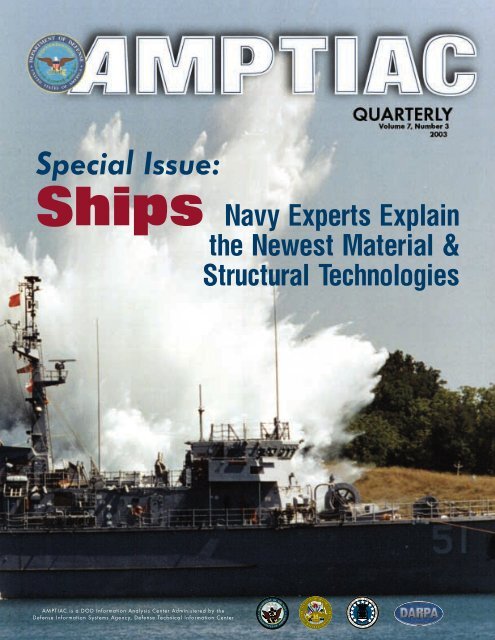The Best of Both Worlds: Hybrid Ship Hulls Use Composites & Steel
The Best of Both Worlds: Hybrid Ship Hulls Use Composites & Steel
The Best of Both Worlds: Hybrid Ship Hulls Use Composites & Steel
- No tags were found...
You also want an ePaper? Increase the reach of your titles
YUMPU automatically turns print PDFs into web optimized ePapers that Google loves.
To InstronUniversity <strong>of</strong> MaineE-glassbeam<strong>Steel</strong>beamUniversity <strong>of</strong> California–Los AngelesFigure 6. Development <strong>of</strong> Joint Concepts, and Understanding Failure Mechanisms.<strong>Steel</strong>Large Scale TestingFigure 5 shows the large, built-up composite-to-steel joints,which will be tested soon. In addition, a proposed half-scale hullmay be tested in the future to gain more confidence in the analysis<strong>of</strong> large scale composite/steel joints under complex sea loadand UNDEX conditions.FRP AdherentBasic Research on Compositeto <strong>Steel</strong> Joints<strong>The</strong> wide application <strong>of</strong> compositesin future ships and submarines (e.g.composite topside, composite mast,composite sail, hybrid hulls etc.), hasopened a new field <strong>of</strong> research injoints. Several studies are underway tounderstand the behavior <strong>of</strong> compositeto steel joints. <strong>The</strong>se investigationscover three areas: development <strong>of</strong> joiningmechanisms, understanding failurebehavior under cyclic and dynamicloads, and development <strong>of</strong> computationaltools for joint analysis. Figure 6hightlights several studies for developmentand analysis <strong>of</strong> various joiningmechanisms: bolting, adhesive joining,composite fasteners, and compliancematching methods.Figure 7 shows some <strong>of</strong> the theoriesand experiments related to dynamicfailure and friction laws that should beconsidered in the failure analysis <strong>of</strong>these large joints. It is imperative thatfriction not be ignored along the entire circumference <strong>of</strong> a hull(or length <strong>of</strong> ship topside) after failure <strong>of</strong> the fasteners and theinitiation <strong>of</strong> interfacial cracks.Figure 8, shows some <strong>of</strong> the analysis and computational techniquesunder development to allow the designer to predict failure<strong>of</strong> interfaces under cyclic fatigue and dynamic loading. <strong>The</strong>yinsertUniversity <strong>of</strong> California–San DiegoLehigh UniversityCalifornia Institute <strong>of</strong> Technology<strong>Steel</strong>Harvard UniversityBrown UniversityBrown UniversityFigure 7. <strong>The</strong>oretical and Experimental Methods for Understanding and Measuring Friction at Interfaces <strong>of</strong> Composite/<strong>Steel</strong> Joints.<strong>The</strong> AMPTIAC Quarterly, Volume 7, Number 3 59
Mathematical formulas,rules, weight ...IMPACT LOADINGAutomatic learning toolsGlobal ScaleComponent ScaleMaterial ScaleRensselaer Polytechnic InstituteUniversity <strong>of</strong> California–San DiegoFigure 8. Development <strong>of</strong> Analytical Methods for Analysis <strong>of</strong> <strong>Hybrid</strong> <strong>Ship</strong>s.cover the use <strong>of</strong> neural networks and expert systems, as well as thedevelopment <strong>of</strong> multi-scale computational methods (covering thescale from interface details to the full scale structure.)APPLICATION OF HYBRID HULL<strong>The</strong> hybrid hull concept was conceived to enable the use <strong>of</strong> compositesin the structure <strong>of</strong> large combatants. <strong>The</strong> emerging needfor fast craft in the Navy however, brought about a new possibilityfor hybrid construction. Fast craft require high fatigueresistance and the use <strong>of</strong> low density materials like aluminum orcomposites. Where many aluminum alloys suffer from poorfatigue performance, composites can be made to possess excellentfatigue resistance, but may lack the stiffness for some <strong>of</strong> the hullforms <strong>of</strong> the proposed fast ships. Figure 9 shows some concepts<strong>of</strong> hybrid construction envisioned for fast ships.Application <strong>of</strong> <strong>Hybrid</strong> HullPentamaran<strong>The</strong>ater Support VesselTrimaranCatamaran<strong>The</strong>ater Logistics VesselSurface Effect <strong>Ship</strong>Fast Patrol BoatFigure 9. Concepts <strong>of</strong> <strong>Hybrid</strong> Construction in Fast Craft.60<strong>The</strong> AMPTIAC Quarterly, Volume 7, Number 3
















